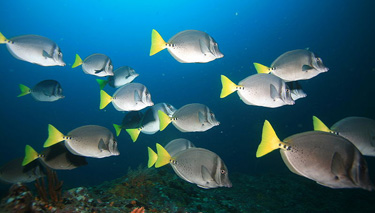
A new study shows that higher fish reproduction inside marine reserves is likely to benefit fisheries outside, as ocean currents carry the tiny, young fish to surrounding waters.
However, the study also indicates that if the young, exported from marine reserves, disperse across large areas it may be extremely difficult to detect a boost to fisheries.
Robin Pelc and three collaborators used a new modeling approach to explore the potential impacts of marine protected areas on fish populations outside the reserve boundaries. The findings appear in a special edition of the Proceedings of the National Academy of Sciences that focuses on marine reserves.
Typically, marine reserves prohibit fishing, oil extraction, seabed mining, or other destructive and extractive human activities. In the last decade, these types of protected areas have become increasingly popular as a tool for ocean conservation and management.
Marine reserves are widely recognized as having many conservation benefits within their borders. Numerous studies have shown that population densities of fish and invertebrate species tend to be higher, biodiversity tends to be greater, and body sizes of fish and invertebrates tend to be bigger.
However, many fishermen oppose new preservation because they do not want to lose access to fishing grounds, and they believe that the same fishing effort will be squeezed into a smaller area outside the reserves.
So far, their opposition has not been swayed by the possibility that marine reserves might boost fisheries by "seeding" surrounding areas with planktonic offspring of fish and invertebrates that drift outside the boundaries. To date, empirical evidence to support this idea has been scant.
Pelc and her coauthors used a “simple idealized coastline model to estimate the expected magnitude and spatial scale of larval export from no-take marine across a range of reserve sizes and larval dispersal scales.” Most notably, they found that,
“Given the magnitude of increased production typically found in marine reserves, benefits from larval export are nearly always large enough to offset increased mortality outside marine reserves due to displaced fishing effort.”
However, the increase at any given point outside the marine reserves would be quite small, meaning it would be nearly impossible to see in field studies. So, while this new research clarifies that marine reserves could benefit fisheries, it also indicates that the positive impact may be extraordinarily difficult to detect.
Managers and conservationists therefore face a daunting scientific challenge if they need real-world data to convince fishermen that marine reserves can help sustain their livelihoods.
--Reviewed by Peter Taylor
Pelc, R., Warner, R., Gaines, S., & Paris, C. (2010). Marine Reserves Special Feature: Detecting larval export from marine reserves Proceedings of the National Academy of Sciences DOI: 10.1073/pnas.0907368107
However, the study also indicates that if the young, exported from marine reserves, disperse across large areas it may be extremely difficult to detect a boost to fisheries.
Robin Pelc and three collaborators used a new modeling approach to explore the potential impacts of marine protected areas on fish populations outside the reserve boundaries. The findings appear in a special edition of the Proceedings of the National Academy of Sciences that focuses on marine reserves.
Typically, marine reserves prohibit fishing, oil extraction, seabed mining, or other destructive and extractive human activities. In the last decade, these types of protected areas have become increasingly popular as a tool for ocean conservation and management.
Marine reserves are widely recognized as having many conservation benefits within their borders. Numerous studies have shown that population densities of fish and invertebrate species tend to be higher, biodiversity tends to be greater, and body sizes of fish and invertebrates tend to be bigger.
However, many fishermen oppose new preservation because they do not want to lose access to fishing grounds, and they believe that the same fishing effort will be squeezed into a smaller area outside the reserves.
So far, their opposition has not been swayed by the possibility that marine reserves might boost fisheries by "seeding" surrounding areas with planktonic offspring of fish and invertebrates that drift outside the boundaries. To date, empirical evidence to support this idea has been scant.
Pelc and her coauthors used a “simple idealized coastline model to estimate the expected magnitude and spatial scale of larval export from no-take marine across a range of reserve sizes and larval dispersal scales.” Most notably, they found that,
“Given the magnitude of increased production typically found in marine reserves, benefits from larval export are nearly always large enough to offset increased mortality outside marine reserves due to displaced fishing effort.”
However, the increase at any given point outside the marine reserves would be quite small, meaning it would be nearly impossible to see in field studies. So, while this new research clarifies that marine reserves could benefit fisheries, it also indicates that the positive impact may be extraordinarily difficult to detect.
Managers and conservationists therefore face a daunting scientific challenge if they need real-world data to convince fishermen that marine reserves can help sustain their livelihoods.
--Reviewed by Peter Taylor
Pelc, R., Warner, R., Gaines, S., & Paris, C. (2010). Marine Reserves Special Feature: Detecting larval export from marine reserves Proceedings of the National Academy of Sciences DOI: 10.1073/pnas.0907368107
No comments:
Post a Comment